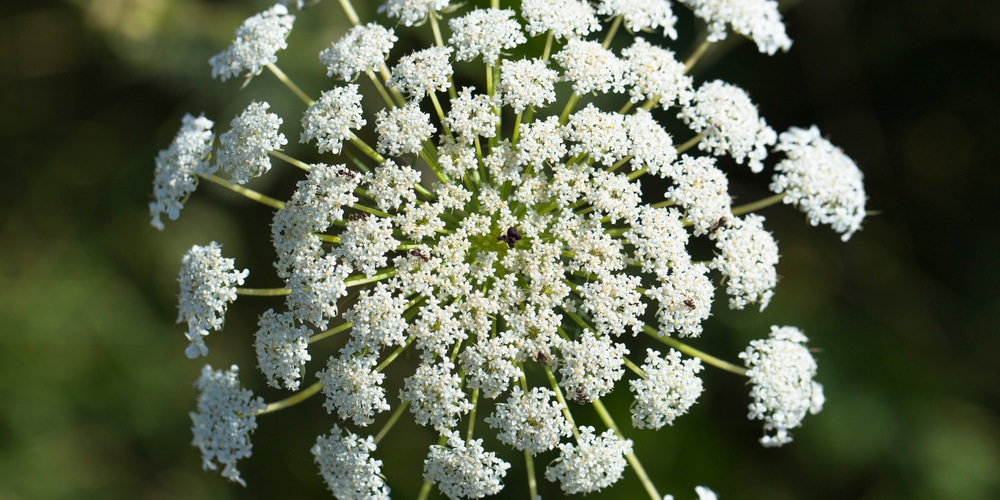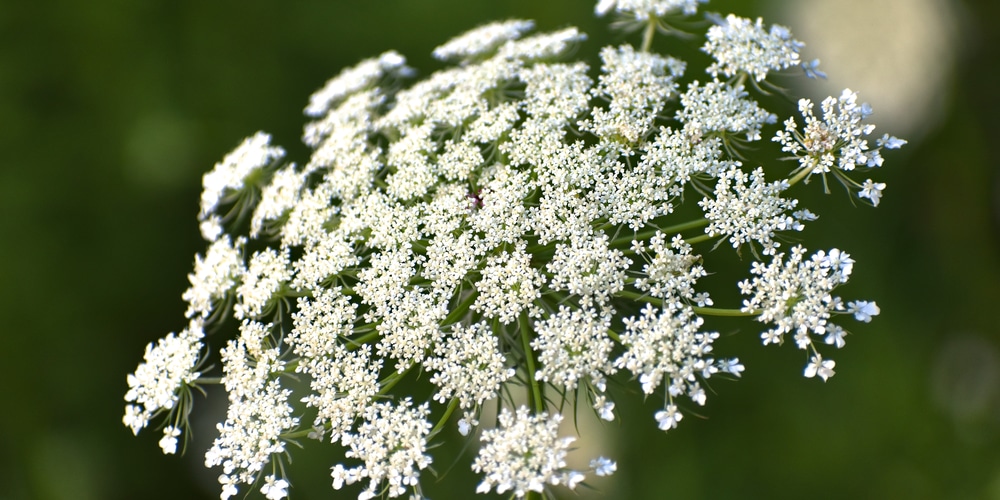Queen Anne’s Lace and yarrow are both beautiful, lacy plants with a similar look. While there are some distinct differences, some people still confuse the two.
Let’s look more closely at Queen Anne’s lace and yarrow individually to uncover their similarities and differences.
Queen Anne’s Lace

Queen Anne’s lace (Daucus carota) is one of the most common roadside invasives in North America. It’s a member of the parsnip family and descended from the cultivated carrot, which originated in Afghanistan. If you crush the taproot, you’ll smell a distinctive carrot-like scent.
It has delicate, lacy white flowers that grow in flower clusters (umbels). Each umbel is 4-5 inches across, while other umbels that branch off from the fuzzy main stem are half the size. Each umbel has hundreds of tiny white flowers, and you will often see a dark purple or reddish floret in the middle of the umbel. The plant usually reaches 1-4 feet in height.
Queen Anne’s Lace has a lot of lookalikes, many of which are dangerous to touch or even deadly. Luckily, Queen Anne’s Lace only causes skin irritation for those who have sensitive skin.
In fact, the umbel is edible raw, or you can batter it and fry it to eat. When they’re young, you can even eat the roots and leaves of Queen Anne’s lace since it’s an ancestor of the carrot. However, by the time the flower appears, the root is too woody to consume.
Keep in mind that Hippocrates prescribed crushed Queen Anne’s lace seeds as birth control over 200 years ago, and modern studies indicate that it can cause miscarriages.
Yarrow
Yarrow (Achillea millefolium) is native to North America and is a member of the aster family. It’s also a plant many people purposefully plant in their flower gardens because it doesn’t require a lot of care and attracts pollinators.
Like Queen Anne’s lace, the yarrow has a showy flower head with many tiny flowers. It comes in yellow, red, pink, and every color in between. It’s when the flowers are the lightest pink and almost white that they’re most often mistaken for Queen Anne’s lace. Both have fuzzy stems as well.
Yarrows are also within the same height range as Queen Anne’s lace, at 0.5-3 feet tall. However, the yarrow’s leaves are more wispy and feathery than Queen Anne’s.
Native Americans had many traditional medicinal uses for yarrow. They crushed the plant to make a salve for wounds and burns, and they brewed tea from its dried leaves to treat colds, fevers, and headaches. Meanwhile, modern studies have found the following medical uses for yarrow:
- A topical anti-inflammatory
- An aid for wound healing
- Treatment for irritable bowel syndrome
- An anti-anxiety medication
- Neurological support
However, people who have allergies to plants in the Asteraceae/Compositae family like chrysanthemums, daisies, marigolds, or ragweed may also have allergies to yarrow plants. And taking it can put a pregnancy at risk for miscarriage.
Queen Anne’s Lace vs Yarrow Similarities
- The flowers look similar
- The plants grow to a similar height
- They both have fuzzy stems
- Neither are poisonous
- Both had traditional medicinal uses
- Both can cause miscarriages
Queen Anne’s Lace vs Yarrow Differences
- Queen Anne’s Lace is white, while yarrow is yellow, red, or pinkish
- There’s no dark purple or red flower in the middle of the yarrow’s umbels
- Yarrow leaves are more feathery
Final Thoughts on Queen Anne’s Lace vs Yarrow
Queen Anne’s Lace and Yarrow look similar and have a history of traditional medicinal uses. While it’s easy to tell yarrow from Queen Anne’s lace, Queen Anne’s lace has a multitude of look-alikes that can make attempting to pick it or use it dangerous or even deadly if you’re not 100% sure of the plant’s identification. Queen Anne’s Lace is also similar to Hogweed.

